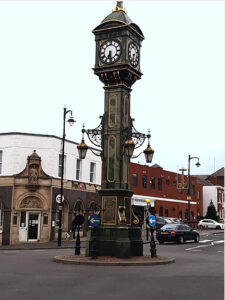
What the Dickens ever possessed me, you might ask, to take a vacation in northwest England, home of the Industrial Revolution!!?? But the once grimy, smoke-filled “Bleak House” cities of Birmingham, Manchester, and Liverpool are in the midst of a renaissance – crowded with new malls, cultural exhibits, and museums – a non-industrial revolution!! There’s so much to see and do that the week I allotted for visiting all three could easily have been devoted to any single one of them. Historic centers of trade and manufacturing, they were strategic targets for submarine attacks and bombing raids during both world wars. Destroyed neighborhoods have been rebuilt into contemporary centers of gleaming shops interspersed with high-rise housing.
Birmingham’s Selfridges department store, encased in a “bubble wrap” metal façade, anchors the multi-level Bull Ring shopping center. Liverpool has converted one of its historic docks into a multi-use mall with shops, restaurants, the Beatles Story exhibit hall, and a branch of the Tate Museum. Manchester’s vast Classical style Royal Exchange has been converted to a mall and in-the-round theater where I saw a delightful production of “The Producers,” and the city’s new Bridgewater Symphony Hall is constructed on bearings to isolate the sound from disturbing vibration. On the outskirts of Manchester in emerging Media Center UK, the Lowry complex of theaters and exhibits lies just across a bridge from the Daniel Libeskind design Imperial War Museum.
But brand new intermingles with historic, and all three cities maintain elements of bygone charm. Birmingham’s half-timber Old Crown Inn still looks much as it must have when Queen Elizabeth I (!) overnighted there. The 1882 Shakespeare Memorial Room, recreated within the gold dome topping the city’s flagship central library, houses and exhibits one of the greatest Shakespeare collections in the world. In Shambles Square beside Manchester’s stately cathedral, you can drink or dine at the relocated and renovated Old Wellington Inn and Sinclair’s Oyster Bar which date back to the 16th century. You could swear it was medieval but the mammoth neo-Gothic Liverpool Cathedral is eleven years newer than the ultra modern glass-domed Metropolitan Cathedral nearby.
Extensive museums in all three cities pay homage to the Pre-Raphaelite and Art Nouveau artists who originated in the region, and former factories and the world’s original train station have been converted to fascinating museums with exhibits tracing the history of toy and cotton manufacturing, emergence of the railroads, the 18th-century triangle slave trade, and resistance to the world wars.
Creative cuisine is a feature of all three cities. The workingman’s mainstay shepherd’s pie is still a popular main course, though now updated with fancy puffy crusts and creative salads. For dessert, each restaurant serves its own version of sticky toffee pudding. Culinary choices range through Lebanese, Pakistani, Japanese. Italian.
Liverpool’s Philharmonic Dining Room is said to be one of Britain’s most beautiful pubs. For finer dining, within a half hour or so of Liverpool are Michelin star restaurants Fraiche, Moor’s Hall and Simon Radley at the Chester Grosvenor. Fans of grand old hotels can book into the literally Grand Hotel in Birmingham or Manchester’s Midlands where Rolls met Royce. Each town has its convenient Radisson Blu.
I enjoyed tracing Birmingham’s extensive system of canals, visiting Manchester’s round library with the children’s section inspired by local author Frances Hodgson Burnett’s “The Secret Garden,” poking into the recreated Cavern bar where the Beatles rose to fame. “A Christmas Carol” was first read in Birmingham’s Town Hall and I’d paraphrase it to describe the three cities I was amazed to discover, “God bless them every one.”
Published in Luxury Web Magazine, September 2022
